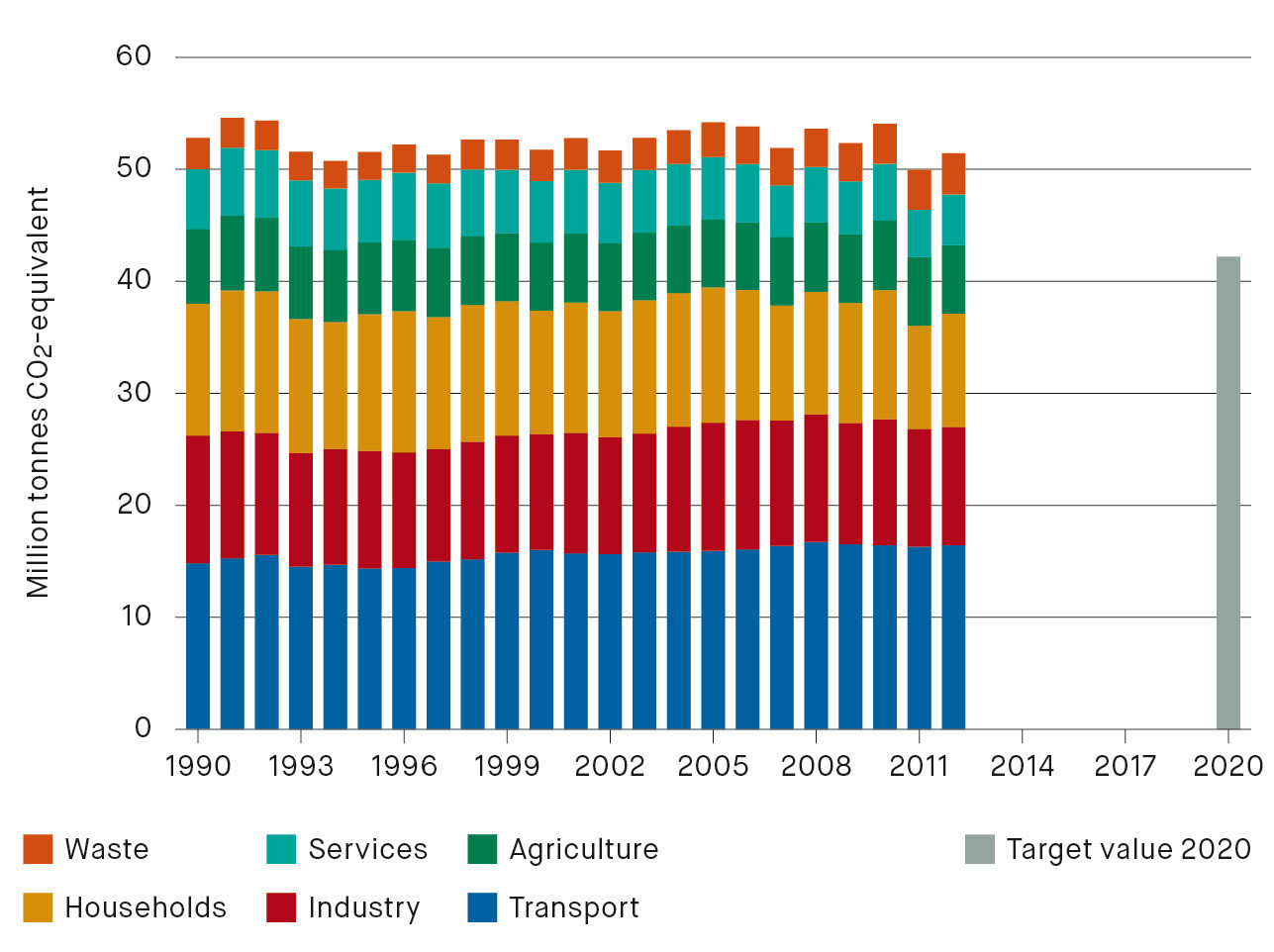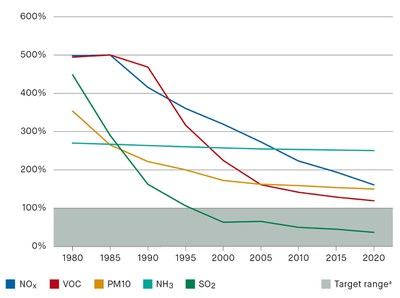Main themes and sectors addressed in the national State of Environment report
The purpose of the State of Environemnt (SOE) reports is to provide clear and accessible information about the state of the environment and the associated trends as required by Swiss law (Federal Constitution[1], Environmental Protection Act[2] and Federal Statistics Act[3]). The reporting is based on appropriate, reliable and relevant information and on validated official data. The information presented in the SOE reports can be used as a basis for environmental and sectoral policy debate.
The SOE reports are divided into three parts: "Stocktaking of Environmental Policy Implementation" (Part I), "State of the Environment" (Part II) and "Trends and Perspectives" (Part III). Their target groups include both decision-makers and the general public. More information on the data and indicators used in the report, is available on the internet[4].
The approach taken in the SOE reports[5] is based on the DPSIR model. Thus, in addition to the environmental topics, the report also explores the main human activities that influence the environment. The following topics are examined: Natural resources, Production, Consumption, Energy, Transport, Settlements, Agriculture, Climate, Biodiversity, Air, Water, Soil, Landscape, Forest, Natural hazards, Noise, Electrosmog.
Key findings of the State of Environment report
Swiss environmental policy has achieved many successes since the 1980s and reduced the pollution of the environment by certain contaminants. As a result, the country's air quality has improved considerably over the past 25 years.
However ambient concentrations of certain pollutants (particulate matter, ozone, ammonia, nitrogen oxides,) still regularly exceed the effect oriented objectives (graph 1). A large number of chemical substances (e.g. drugs, personal care products, plant protection products) are not filtered out by wastewater treatment plants and cause damage to ecosystems in the form of micropollutants.
In Switzerland, 1.6 million people are exposed to excessive levels of noise. Over 930 000 people are also exposed to excessive levels of noise at night. Despite the implementation of comprehensive measures in facilities that generate excessive levels of noise, the population is still not adequately protected against noise. The effectiveness of noise abatement measures often fails to compensate for the increase in noise arising from the growing volumes of traffic.
The quality of surface waters and groundwater is generally good today. The input of heavy metals such as lead and cadmium by deposition from air has declined and the registration of polluted sites is country-wide achieved. Overall, there are fewer polluted sites in Switzerland than previously assumed and the programme for the remediation of contaminated sites is on target.
Since the mid-1980s, more resources are used globally than are replaced through regeneration. Switzerland consumes over twice the volume of resources that can be sustainably provided by the earth. To meet its requirements for production and consumption, Switzerland imports increasing volumes of raw materials, e.g. fuels and metals, feed and food. Imported products can be associated with very severe environmental impacts, for example when sensitive ecosystems like tropical forests are affected. Over half of the environmental impacts generated through our domestic consumption arise abroad.
The pressure on Switzerland's own natural resources is also high: the pressure on surface waters and landscape is growing through high energy consumption, increasing mobility and the constant expansion of settlement and transport areas. Soil sealing continues at an increasing rate. This is mainly reflected in the decline of biodiversity.
Switzerland could be particularly severely affected by climate change: according to new climate scenarios[6], an unchecked rise in global greenhouse gas (GHG) emissions could increase temperatures by over 6°C compared to pre-industrial times by the end of the 21st century. Despite the efforts made at the international level, it has not been possible to stem the rise in GHG emissions up to now.
Switzerland is connected with the entire world in a variety of ways: ecological, economic, social and political systems interact constantly. The pressure on important natural resources is rising throughout the world while biodiversity is in decline. The improper management of chemicals and waste, and emissions of particulate matter and ground-level ozone cause extensive impacts on the environment and health.
Main policy responses to key environmental challenges and concerns
In response to the current environmental problems, the Federal Council passed the Green Economy Action Plan[7] in March 2013, which encompasses 27 measures proposed aiming at fostering approaches to economic activity and consumption that conserve resources.
Based on this Action Plan, the Federal Council has proposed to develop and modernize Switzerland's environmental policy through the amendment of the Environmental Protection Act (EPA)[8]. The amendment will establish the framework for the promotion of ecologically sound consumption patterns, the strengthening of the circular economy and the provision of information on resource efficiency. Voluntary initiatives involving business, science and society will be promoted. Given the importance of Switzerland's environmental impact abroad, its international commitment to the improvement of resource efficiency shall also be increased.
To ensure the long-term conservation of biodiversity, the Federal Council passed the Swiss Biodiversity Strategy[9] in April 2012. The federal authorities will develop an action plan by mid-2014 which will substantiate the strategy's objectives. An important milestone has also been reached in the area of water protection: the revised Waters Protection Act[10] contains provisions for the restoration of rivers and lakes so that they can fulfil their natural functions again and contribute to the conservation and promotion of biodiversity. The cantons[12] have already completed their strategic plans for the rehabilitation of watercourses and reduction of the negative impacts of hydropower production. The first projects are already being implemented.
However, Switzerland's decision to phase out nuclear power and the associated expansion of hydropower production make the simultaneous task of conserving or re-establishing natural habitats and landscapes a challenging one.
 For 1990 the reference value belongs in accordance with "Switzerland's Initial Report - Update following the UNFCCC Review", 2007.
For 1990 the reference value belongs in accordance with "Switzerland's Initial Report - Update following the UNFCCC Review", 2007.
Source: Federal Office of the Environment
Considerable action is also required in this area of climate change, particularly in relation to transport. Although the country has succeeded in reducing CO2 emissions from heating fuels compared to 1990 levels, transport-related emissions have continued to increase (graph 2). Hence, the country's domestically and internationally defined emission-reduction targets could only be achieved through the purchase of emissions certificates for climate protection projects abroad.
In the revised CO2 Act[11], which came into force on 1 January 2013, Switzerland set the goal of reducing its domestic greenhouse gas emissions by at least 20 % under their 1990 levels by 2020. At the same time, the federal authorities will also coordinate measures for adaptation to climate change. For this purpose, a national strategy for adaptation to climate change was developed. Its first part was adopted in March 2012. Key elements are:
- general objectives and principles of adaptation,
- sectoral strategies for those sectors most affected by climate change in Switzerland, and
- a summary of the most significant challenges the country is facing in adapting to climate change.
In the second part of the strategy, adaptation measures of the federal offices are presented and coordinated in a joint action plan. It will serve as framework for adaptation for the period 2014-2019.
Country specific issues
The future state of Switzerland's environment will be influenced by global trends but steered by regional and local factors. While climate change could become more noticeable in the Alpine region than in other regions of the world (e.g. glacier recession, permafrost melt, changes in vegetation), Switzerland is currently unaffected by the water scarcity problems encountered elsewhere. In Switzerland, biodiversity is heavily dependent upon the implementation of the various measures set out in the Action Plan on the Swiss Biodiversity Strategy.
Switzerland could be particularly severely affected by climate change, as the negative impacts clearly outweigh the positive impacts in the long term. But Switzerland's robust economy can be effectively used to properly adapt to climate change and counteract its consequences for society. At the same time, due to its global business network, resource dependence and sense of ethical responsibility, Switzerland cannot disregard global developments.
Switzerland's water prospects seem relatively positive. Virtual water use, specifically in imported goods, is particularly important. Just like climate change, water scarcity abroad can also cause humanitarian crises that could be clearly felt in Switzerland.
Unlike in climate change, Switzerland seems to be able to steer its own future developments in biodiversity change. The full package of measures included in the Action Plan on the Swiss Biodiversity Strategy outlines how Switzerland will reach the targets set out by international agreements. The state of meadows, forests and bodies of water is greatly affected by their respective use in agricultural, forestry and water management activities. Switzerland's high population density compared to the rest of the world also makes settlement and transport areas a very influential factor.
In Switzerland, as in most other countries, nitrogen fluxes are significantly affected by agricultural inputs. Different target-oriented measures to reduce nitrate leaching and ammonia emissions have been introduced, but the environmental objectives are not yet achieved.
Switzerland's strong economy increases its opportunities for tackling larger environmental challenges. However, economic prosperity itself also has a dominant influence on climate, water use, biodiversity, the nitrogen cycle and other environmental compartments.
Through its current policy decisions and the measures it is now introducing, Switzerland is plotting a course for the future state of the environment. In doing so, it will need to make use of international opportunities (e.g. for binding GHG reduction targets), as well as national and local opportunities (e.g. for conserving and improving natural habitats or environmentally-friendly forms of management).
A forward-looking and comprehensive vision of natural resource management, like the one pursued by the green economy, will also be increasingly important.


Document Actions
Share with others